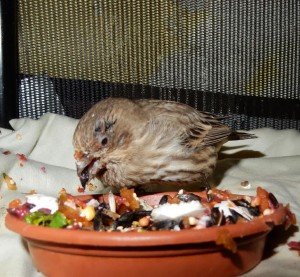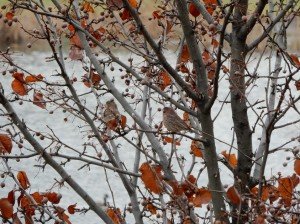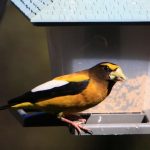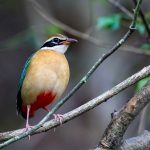
Today’s Guest Blog was written by Arden Zich, volunteer with Fox Valley Wildlife Center in Elburn, IL:
Congratulating myself for leaving the house on time, I got into my car and drove off to meet up with a friend for lunch. Not one minute later, I noticed a small feathery mass sitting in the middle of my lane. Giving the bird a wide berth I veered towards the other side of the road, assuming she would fly off. As I drove past her, I glanced in my rearview mirror. She hadn’t budged. I felt compelled to go back and see if the bird was just being fickle, or if it was something else.

As I approached on foot, I expected her to fly off in a flurry but once again she did not. She moved her head around a bit but that was all. Once I got close enough, I reached out and grabbed her. That was definitely a bad sign; it’s almost impossible to just walk up to and snatch a healthy adult wild bird. Upon initial inspection, I noticed that one eye was squinty and the other was red and completely swollen shut. It looked like conjunctivitis, and she would need rehabilitation.
I was going to be late for lunch.
Since I had no way to safely contain her in the car, I made the short drive back home with her clutched in one hand. Fortunately I was able to get an assist from my husband, who set up a shoebox for the poor bird’s ride to the local wildlife rehabilitation facility, Fox Valley Wildlife Center, which was conveniently located just five minutes from my dining destination.

Less than 24 hours after receiving medication, the eye that had been swollen shut had opened enough for her to see again. Laura Kirk, the wildlife center’s director, said that the bird couldn’t inhale her seeds fast enough once she was set up in her own private quarters. The difficulty she had seeing me come at her must have meant that she’d had a hard time finding food as well.
Not long after her arrival, a male House Finch was admitted with the same malady. Together they stayed in the bird infirmary for a few weeks while being treated with medicated eye drops and an antibiotic in their drinking water, providing company and comfort to each other.
Once their treatments were complete, they were transferred to a soft release outdoor cage for observation and to readjust to the weather. With no netting between them, the pair was free to frolic about as they pleased until they were cleared for release. When that time came, the couple was chauffeured to the general area where the female finch was found.

Opening the carrier door was a bit uneventful, as neither bird chose to leave immediately; they wanted to make sure the coast was clear before leaving their protective confines. Once one finch finally took flight, the other immediately sprang forth in the same direction. Together they flew to a nearby tree to take in the sights and sounds of their new surroundings, and possibly to stake their claim as a pair.
Mycoplasmal conjunctivitis is a highly-contagious disease that primarily affects House Finches but can also affect Purple Finches and American Goldfinches. Birds can recover from the disease if they don’t first succumb to predation or starvation from the inability to see, which was undoubtedly imminent for “my” House Finch.
It is highly recommended that those who enjoy feeding birds ensure that feeders are spaced far enough apart to avoid crowding, clean feeders on a regular basis, and provide only enough seed for about one to two days. Feeders should be immediately removed and sanitized (10% bleach solution) and feeding area cleaned if sick birds have been observed in that area.
For more information and tips on how to help decrease spread of disease:
The Cornell Lab, Project FeederWatch House Finch Eye Disease












Thank you for saving this little bird, Arden, and for educating about mycoplasmal conjunctivitis. You did a mitzvah for sure.
Thanks, I appreciate that Meredith! There was no way I could have left her there knowing help was available. (I also now finally have a nice little critter containment kit in my car, just in case.)